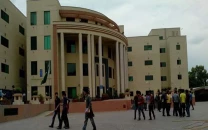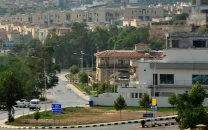Flood relief practices deepen Pakistan's education crisis
When every monsoon washes away classrooms, Pakistan isn’t just losing schools, it’s losing futures

Pakistan ranks among the world's most climate-vulnerable nations. As monsoons intensify and floods become more frequent, the country's already fragile education system faces a deepening crisis. Natural disasters, particularly recurrent floods, routinely damage school infrastructure, displace communities and disrupt learning. Yet, relief practices often treat education as an afterthought, converting schools into shelters and compromising educational continuity. The result: generations of children lose not only classrooms but also opportunities.
Each monsoon season, floodwaters ravage classrooms, wash away textbooks and force schools to shut down. In many districts, school buildings, often constructed with minimal resilience, are either destroyed or declared unsafe. In others, schools that remain structurally intact are repurposed as emergency shelters, displacing students and teachers alike. This double burden of physical destruction and use as relief hubs renders classrooms inaccessible for weeks or even months.
The scale of the problem is staggering. During the 2010 floods, more than 10,000 schools were damaged or destroyed, while over 5,600 were used as relief shelters. In 2022, estimates suggest that over 22,000 schools were damaged or destroyed, another 5,000 were turned into relief camps, and around 3.5 million children had their education disrupted (UNICEF, 2022; World Bank, 2023). The 2025 floods further worsened the crisis — nearly 30,000 schools were shut down, affecting the education and learning continuity of around 700,000 children in Punjab alone, according to PDMA.
Inside flooded schools, desks vanish or are burned for fuel; blackboard walls become lines for drying laundry; and textbooks disappear under piles of relief supplies. Displaced families occupy classrooms, often bringing their livestock along. In this process, schools already underfunded and overcrowded become casualty zones. The long-term effects are severe: dropout rates rise, particularly among girls and marginalised communities, while enrolment levels remain depressed for years after disasters.
This cycle persists due to deep structural and policy failures. Schools are often converted into shelters not out of neglect but because of poor planning and lack of alternatives. Pakistan spends less than 2% of its GDP on education, one of the lowest shares in South Asia. Consequently, many public schools are built with weak foundations and non-resilient materials, leaving them highly vulnerable to floods. Post-disaster repairs and reopening can take months, further prolonging learning disruptions.
If Pakistan is serious about safeguarding its future, education must be integrated into disaster relief — not sidelined. Immediate measures should include:
1. Separate relief shelters from schools. Use community centres, vacant government buildings or purpose-built facilities to house displaced families, allowing schools to remain functional.
2. Design flood-resilient infrastructure. Elevate school foundations; build multipurpose halls that can double as shelters without displacing classrooms; and use durable, flexible materials.
3. Deploy alternative learning mechanisms. When schools are unusable, establish mobile classrooms, learning tents, remote or digital platforms and temporary learning spaces, especially in rural areas.
4. Create dedicated education disaster funds. Allocate specific budget lines for rapid repairs, emergency learning kits, teacher training and operations ensuring education continuity.
5. Empower local education governance. Equip and train local administrators to manage relief efforts without halting schooling, and integrate education planning into disaster response frameworks.
Education is not a luxury — it is a lifeline. Every child denied schooling because their classroom has turned into a shelter loses a piece of their future. Floods may be natural, but our response is a matter of policy and political will. The question remains: will we continue to let floodwaters wash away the next generation's potential?















COMMENTS
Comments are moderated and generally will be posted if they are on-topic and not abusive.
For more information, please see our Comments FAQ